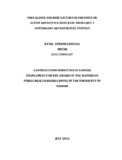| dc.description.abstract | Background Hepatitis B Virus (HBV) and HIV are two diseases which spread in the same manner, but HBV is more infectious than HIV -1 during the infectious period. Active HBV requires modification of HIV -1 therapy and is associated with increased risk for transmission of HBV. We aimed to determine the prevalence of HBV and knowledge of HBV among HIV-I discordant couples with no history ofHBV vaccination.
Methods We conducted a cross-sectional study within the University of Washington Partners Pre-Exposure Prophylaxis (prEP) study in Nairobi and Thika. 81 discordant couples per site in Nairobi and Thika were enrolled by use of structured questionnaires to determine the prevalence, knowledge and aw~eness of HBV infection in discordant HIV -1 couples. Previous HBV status was determined by HBsAb positive test and active HBV status was determined by HBsAg test positive.
Results A total of 161 couples (322 participants) were enrolled; couples in which the tIIV infected partner was female (index partner) accounted for 37% while couples in which the index partner was male was 13%. Overall, 31% participants had at least one positive serologic marker for HBV. The prevalence for active HBV (HBsAg) was I %, with previous HBV prevalence (HBsAb) at 30%. The mean age was 33 years (SD 8.4).
Prevalence: HBV prevalence was higher among HIV positive women compared to HIV negative women (10.2% vs. 5.9% p=0.05, OR 0.5, CI 0.2-1.0). However, among the men, there was a higher prevalence of HBV among the HIV negative than the HIV positive participants (8.4 vs. 6.2% p=0.04, OR 3.0, CI 1.3-6.5). Among the HIV negative participants, there was a higher prevalence of HBV among the men (16.8%) than the women (11.8%) (p<0.01, OR 2.6, CI 1.2-5.9), while among the HIV positive participants there was a higher prevalence of HBV among the women (20.5%) than the men (12.4%) (p=0.03, OR 0.4, CI 0.2-9.8). We found increasing prevalence of HBV with increasing age (p=0.001, OR 1.6, CI 1.2-2.1). HBV and HIV infection were not associated (p=0.4). Overall, 61(38%) couples were discordant for HBV, 81(50%) couples were concordant negative for HBV and 19 (12%) couples were concordant positive for HBV
Knowledge of HBV: A total of 62.11 % had heard of HBV with 8% of them having adequate knowledge of HBV. HIV positive participants with adequate knowledge were 13% of compared to 3.7% of HI V negative participants (p=O.05 OR 2.7, CI O.95-7.9).Those who had one positive serological marker for HBV were not more likely to have adequate knowledge of HBV than those without a marker.
Conclusions and recommendations: A discordant couple with a HIV positive woman had a significantly higher HBV prevalence rate than a discordant couple with a HIV negative woman. HBV knowledge is inadequate among the HIV negative participants; this is a target group for health education regarding risk factors of HBV infection and HBV vaccination to prevent HBV infection. | en_US |

